(Updates are posted in Exhibitions on the Fabergé Research Site)
-
December 6, 2008 – January 18, 2009 The National Museum, New Delhi, India Faberge – The Priceless Jewellery of the Russian Empire
196 pieces are on loan from leading Russian museums: the Moscow Kremlin Museums, the State Historical Museum, the Fersman Mineralogical Museum, the Pavlovsk Museum and Palace, and “The Link of Times” Foundation. (Courtesy Tatiana Muntian)
-
December 10, 2008 – March 29, 2009 The Victoria and Albert Museum in London Magnificence of the Tsars
Elaborate uniforms of the Russian court from 1720 to the early 20th century are shown. (Courtesy John Jenkins)
-
December 26, 2008 – May 17, 2009 Detroit (MI) Institute of Arts
Master Pieces: Chess Sets from the Dr. George and Vivian Dean Collection includes a Fabergé chess set.
-
January 23 – February 1, 2009 New York City
Annual Winter Antiques Show – A La Vieille Russie exhibiting. Their annual catalog, Russian Works of Art, is now available.
- March 13 – 22, 2009 Maastricht, the Netherlands
European Fine Art Fair (TEFAF) – A La Vieille Russie and Wartski exhibiting.
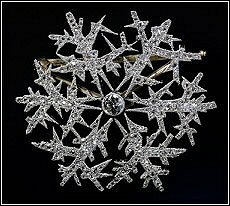
Alma Pihl Snowflake Brooch.
Provenance: Nobel Family
(Courtesy Ulla Tillander-Godenhielm)
-
Fabergé Thimbles
Thimble enthusiasts Magdalena and Professor William Isbister, a retired surgeon, have done a very thorough literature search and discuss their findings on Fabergé thimbles in a well-researched, illustrated paper.An outgrowth of this research is that Karl Gustav Lundell, attributed as a Fabergé ‘workmaster’ in recent publications and on websites, died on May 29, 1856, and never qualified as a workmaster. Confirmed archival research on this gentleman was first published in Tillander-Goldenhielm, et al. Carl Fabergé and His Contemporaries, 1980, 46-47.
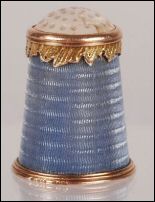
Fabergé Thimble by M. Perchin
-
The 1890 Fabergé Danish Palaces Egg – The Miniatures Explained
Christian Steener Eriksen from Copenhagen questioned the identity of the third panel from the left in the Danish Palaces Egg. Traditionally in Fabergé literature it had been identified as Hvidøre, the house in Denmark to which the Dowager Empress Maria Feodorovna retired after the 1917 Revolution. He observed that the Danish Palaces Egg was made in 1890 and the Empress and her sister only bought the house in 1906!
Using Internet tools Annemiek Wintraecken and Mr. Eriksen found the correct identity, and the very image that was probably used as a model by Konstantin Krijitski to paint the miniature of the Kejserens Villa. On her website, Ms. Wintraecken has juxta-opposed the 10 miniatures from the Danish Palaces Egg with contemporary and modern photographs of the palaces and yachts depicted. Thank you, Mr. Eriksen for this astute question!
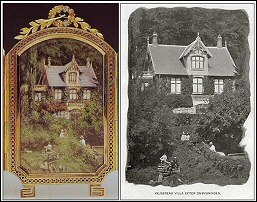
Danish Palaces Egg – The Kejserens Villa
-
Blue Serpent Egg Redating
Excerpts of reader’s responses on the redating hypotheses suggested by Annemiek Wintraecken in the Fabergé Research Newsletter, November 2008, have been compiled with the writer’s permissions:Toby Faber (Author, The Extraordinary Story of the Masterpieces That Outlived an Empire):
I like your theory about the mix-up between the 1887 and 1895 egg. It seems to fit the facts and the picture better than the current attribution – we can be pretty sure, I think, that the surprise from the 1896 egg was lent to the 1935 Belgrave Square Exhibition by Grand Duchess Xenia (see Lowes and McCanless, Fabergé Eggs: A Retrospective Encyclopedia, 46). Doesn’t that make it quite likely that she also possessed the egg itself – i.e., (assuming you’re right) the 12 Monogram Egg? It seems to make it more likely that the 12 Monogram Egg came to the West with Marie Fedorovna, before ending up in the possession of the mysterious ‘Mrs Berchielli’.Alex Mogilevski (Fabergé enthusiast from Russia):
I found your recent research on the Blue Serpent Clock Egg extremely interesting! Indeed the telegraphic style used to describe the Easter Eggs in the invoices presented to the Court makes the correct attribution of some eggs quite difficult. Therefore, I am sure that your research is an important contribution to the Quest! … We cannot ignore the opinion of Marina Lopato regarding the unbelievably low price for such a sophisticated egg and its very sophistication for such an early period … Since you are corresponding with most learned Fabergé scholars, I wonder whether you had a chance to discuss your findings with Valentin Skurlov, the leading Russian expert on Fabergé.Geoffrey Munn (Wartski):
How marvellous! I am not the only person who will be thrilled to see this published.Vincent Palmade (Fabergé enthusiast):
I think you are right that the egg on the left of the second shelf from the top is the 1887 Easter Egg – the white horizontal band does look like the band where the hours would be indicated together with the head of a snake pointing to them. Furthermore, the golden stripes on the upper half of the egg are clearly in the style of the Faberge objects from the mid 80s (e.g., Kollin).Scott Ruby and the Curatorial Staff of Hillwood Estate, Museum, & Gardens:
After reading Annemiek Wintraecken recent article concerning the re-dating of our Twelve Monogram Egg, Hillwood Estate, Museum, & Gardens feels it must reply to her findings and assert that the arguments set forth in her article are largely based on invoice descriptions and her own hypotheses. There is no proof at present to firmly support any of the theories she claims demand a re-dating any of the Imperial Easter Eggs. While it is possible the Twelve Monogram Egg could, in fact, date to 1896 without further research and evidence, Hillwood Estate, Museum, & Gardens will not change the dating of the Twelve Monogram Egg at the present time.Ulla Tillander-Godenhielm (Fabergé scholar and author):
It is not the clock of the Blue Serpent egg, which attracts the eye in this magnificent object, rather it is the superb blue émail en ronde bosse and its advanced technical details performed by truly skilful goldsmiths. In this egg, I see the ‘mature Fabergé’, and find it difficult to believe that the young newcomer Mikhail Perkhin could have supervised the production of such a complicated object.If the Blue egg was made as early as 1887, it is odd and unusual that Fabergé would repeat this ‘Sèvres porcelain vase model’ some 15-17 years later in three of his truly important commissions (Duchess of Marlborough 1902, Rothschild 1903, Kelch 1904).
When a designer/jeweller/artist has a good idea, he/she does like to make variations on this theme, but then goes on to create something new. If I could ‘blindly’ put a date on the Blue Serpent egg it would be the year 1901 or 1902 …
(Editor’s note: Dr. Marina Lopato [Fabergé: Imperial Jeweler, 1993] already suggested the Blue Serpent Clock Egg was too sophisticated for this relatively early date of 1887.)
Géza von Habsburg (Fabergé scholar and author):
… really happy that the mystery of the date of the Blue Serpent Egg has been satisfactorily solved. All these years I have been saying that the egg had to be much later due to the superb quality of its enameling, a technique (émail en ronde bosse) which was not yet fully mastered by Fabergé around 1885 (see the somewhat uneven, blotchy quality of the enamel on the 1884 Bismark Box [Munich 1986, cat. 404]), especially on its curved sides.
-
1900 Paris Exposition Universelle Discoveries
Stephen Harrison, Cleveland Museum of Art, writes that he discovered two Fabergé objects, a desk clock owned by Hillwood Museum in Washington (DC) which resembles the James Cox clock at the Walters Art Museum, and the Danish Palaces Egg in the Matilda Geddings Gray Foundation Collection, were shown at the Exposition Universelle in Paris in 1900.The objects are on view in the Artistic Luxury exhibition closing January 18, 2009. Other Fabergé eggs on view are the Pansy Egg (recently restored and last seen publicly in San Diego in 1989), the Rose Trellis, Red Cross Egg, Cartier Tsarevitch Egg, Kelch Rocaille and Bonbonniére Eggs, and Cleveland Lapis Lazuli Egg. Exhibition moves next to San Francisco where it will be hosted at the Palace of the Legion of Honor from February 7 – May 31, 2009.
- The late Mr. David A. Braver, an avid collector of Fabergé frames, has left his collection to the Metropolitan Museum of Art. (Courtesy Dr. Géza von Habsburg)
- Exhibition catalog, Masterworks of Fabergé: The Matilda Geddings Gray Foundation Collection, by John W. Keefe is now available from Cheekwood Botanical Garden & Museum of Art, Nashville, Tennessee. Contact: Christy Hager.
- Objects of Desire: Fabergé from the Hodges Family Collection on view through January 18, 2009, at the New Orleans Museum of Art will have an exhibition catalog available February 2009. Contact: 504-658-4116. (Courtesy Jim Mulvihill)
- Peter Carl Fabergé and the Other Russian Masters, opened December 8, 2008, as a permanent exhibition at the New Orleans Museum of Art.
- Daniel Bibb, lender of Fabergé silver and other art objects to the New Orleans Museum of Art, is also an icon enthusiast. On his website he has a slide show of the recent Windows of Heaven exhibition at the museum.
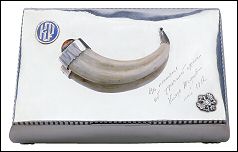
Box Inscribed by Prince Yusupov, Bibb Collection
(Courtesy NOMA)
-
Anne Odom & Wendy Salmond are guest editors of a new book, Treasures into Tractors: The Selling of Russia’s Cultural Heritage, 1918-1938, in which scholars cover in detail four topics:
– Soviet Culture after the Revolution
– Soviet Museums and the First Five-Year Plan
– Sales in Europe and the United States
– Imperial Libraries and Archives.Published in Canadian American Slavic Studies, vol. 43, no. 1-4, 2009. Contact: Charles Schlacks, Jr., or available in February 2009 as a book from the Washington University Press and Hillwood Museum.
- Yoo, Hee-Gwone and Kristen Regina, Visual Resources from Russia and Eastern Europe in the New York Public Library: A Checklist describes nearly 900 heavily illustrated books, journals, posters, engravings and prints as well as original works of art on paper, principally from the 18th to the early 20th centuries. Contact: Ross Publishing.
-
The Fabergé Arts Foundation (FAF) of Washington (DC) and St. Petersburg (Russia), and Christian Bolin of the Swedish Court Jeweller W.A. Bolin, are co-sponsoring the Sixth International Jewelers Competition in Stockholm from August 11-16, 2009. Young Russian, Scandinavian and jewelers from the Baltic countries will compete for the Russian-Nordic jewelry awards during the Swedish Cultural Festival.
A travel experience for Friends of FAF including three days at the Festival, a three-day historical tour of St. Petersburg, and a one-day boat excursion to Tallinn, Estonia, is planned. Contact: FAF or 301-986-1576.
- Hermitage Museum has a virtual tour and viewers may search the museum’s Fabergé holdings using the workmaster rather than the generic Fabergé term in the “search-function”.
- “Rare £15,000 Faberge umbrella saved from car boot sale” is to be auctioned by Bearnes, Hampton and Littlewood in the UK on January 28, 2009. (Courtesy Daryl Chi-Wen Dao)
- Art & Auction, December 2008, in an article entitled Across the Universe details the growth of fairs, auction houses and museums to new regions and new audiences in the world. Mentioned is Alexander Ivanov’s Fabergé Museum in Moscow, and Baden-Baden. No further details are given.
- Valentin Skurlov has updated his research on hardstone figures in the October 2008 issue of the Russian journal, Антикварное Oбозрение (Antique Review).
- Ulla Tillander-Godenhielm, author of a lavishly illustrated book Fabergé ja hänen suomalaiset mestarinsa on Fabergé workmasters from Finland (contact), writes, “we unveiled two text and picture panels with extensive media coverage and a large audience, for Knut Oscar Pihl, (1860-1897) and his daughter Alma Pihl (1888-1976), and one for Erik Kollin (1836-1901) at the birthplaces of Mr. Pihl and Mr. Kollin. A few years ago we did the same for Henrik Wigström (1862-1923), and we have plans of continuing now with Hjalmar Armfelt (1873-1959) and perhaps with other Finnish masters.”
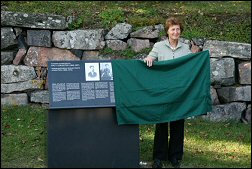
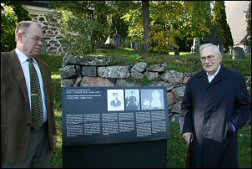
Ulla Tillander-Godenhielm, Mr. Ernst Knape, owner of the estate Brödtorp in Pojo, Finland, where Erik
Kollin was born, and on the right, Mr. N.H. Simberg, Fabergé enthusiast and collector at the Pihl unveiling
